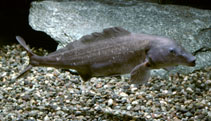| Family: |
Mormyridae (Elephantfishes) |
| Max. size: |
100 cm SL (male/unsexed) |
| Environment: |
demersal; freshwater; depth range 0 - 70 m, |
| Distribution: |
Africa: known from Lower Nile up to Lake Victoria basin (Ref. 1878), including Baro system in Ethiopia (Ref. 54860). Present in Lakes Victoria, Kyoga, Albert, Edward and George, the Victoria and Murchison Nile (Ref. 34290), and Middle Akagera system (Ref. 46152). Also known from Lake Turkana basin and Northern Ewaso Nyiro (Ref. 52331). |
| Diagnosis: |
Dorsal spines (total): 0-0; Dorsal soft rays (total): 55-75; Anal spines: 0-0; Anal soft rays: 17-22. Diagnosis: snout long, about equal to the post-ocular length of the head (Ref. 28714), produced into a stout trunk whose thickness and angle to the face are variable (Ref. 34290). Dorsal fin very long, more than twice the anal fin length, with less than 75 rays, its origin above or slightly in front of the insertion of the pelvic fins (Ref. 4903, 28714).
Description: body depth 3.5-5 times in SL, length of head 4-5 times (Ref. 4903). Dorsal head profile straight or somewhat curved, sloping steeply (Ref. 4903, 34290). Snout produced into a stout trunk whose thickness and angle to the face are variable (Ref. 4903, 34290), its length equal to, or slightly shorter than, the post-ocular part of the head (Ref. 4903, 28714). Eye small (Ref. 4903, 34290), its diameter contained 1.5-2.5 times in the interorbital width (Ref. 4903). Mouth small and terminal (Ref. 4903), lips thick (Ref. 4903, 34290). Teeth notched, 4-7 in the upper, and 8-10 in the lower jaw; dorsal fin with 55-75 rays, originating above or in front of the pelvic fins; anal fin short, with 17-22 rays; caudal fin almost entirely covered with small scales; lateral line with 80-116 scales; 26-32 scales round the caudal peduncle, which is 1.5-2 times as long as deep (Ref. 4903).
Coloration: dull bronze above, lighter below (Ref. 4903, 34290). |
| Biology: |
Solitary, nocturnal species (Ref. 28714). In Lake Victoria in both coastal and offshore waters (Ref. 4903). May spawn in the main lake, perhaps in deep water over rocks (Ref. 52083). In Lake Kyoga in open water rather than weedy areas (Ref. 55624). Bottom feeder; small fishes eat lithophilic insects; adults almost exclusively insectivorous; chironomids dominate in the diet (Ref. 12526). Oviparous (Ref. 205). |
| IUCN Red List Status: |
Least Concern (LC); Date assessed: 15 December 2015 Ref. (130435)
|
| Threat to humans: |
harmless |
Source and more info: www.fishbase.org. For personal, classroom, and other internal use only. Not for publication.

